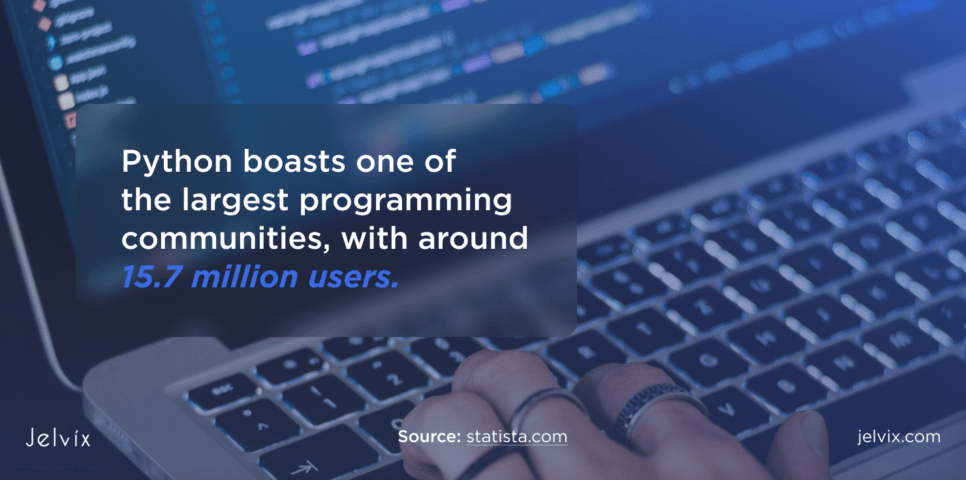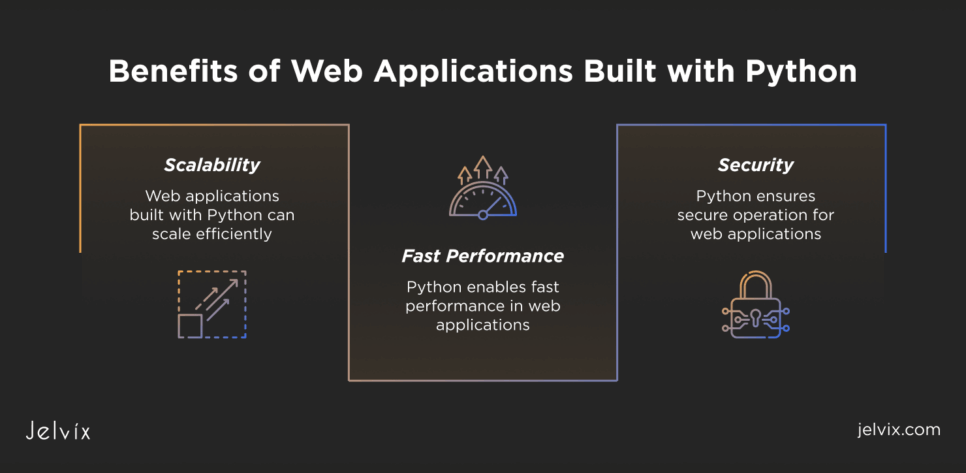Python is a multi-paradigm, versatile, and dynamic programming language that has been constantly developing for over 30 years. As of October 2024, it is ranked number one in the TIOBE Index, which measures programming languages’ popularity. Getting to the top is easier than getting a foothold there. The TIOBE also ranked Python as the most popular language of the year in 2007, 2010, 2018, 2020, and 2021. This success was not due to chance but due to the capabilities of this programming language.
This article reveals Python’s advantages for building robust and scalable web applications. It also provides five Python application examples: globally acknowledged web services that harness Python for daily operations.
So, how can you benefit from using Python for your web development project? Read the following section to learn more.
Benefits of Python for Web Development
Python has gained popularity among web developers for several reasons. You can learn about them below:
- Simplicity and readability: Python’s straightforward syntax allows developers to code and maintain the source code base easily;
- Versatility and flexibility: Python supports various programming styles, including functional and object-oriented paradigms, making it adaptable for different projects;
- Integration potential: Python seamlessly works with other technologies, such as data science and machine learning, enabling the development of rich, data-integrated websites;
- Comprehensive toolkit: The language has powerful libraries and frameworks like Django and Flask that support creating scalable applications;
- Security and dependability: Python offers a variety of built-in security features, and its frameworks, like Django, protect against common security threats. Its enduring presence in web programming has resulted in a strong and developed language highly compatible with contemporary web applications;
- Scalability and performance: Python’s ability to scale efficiently and strong performance establish it as a top choice for web development;
- Community support: Python boasts one of the most significant programming communities, with around 15.7 million users, where developers actively share tools and knowledge.
Top 5 Websites Built Using Python
Let’s discuss the most well-known web application examples of Python’s practical usage. Below is information about popular web services and how Python powered them, providing their users with a high-class experience.
1. Instagram
Overview:
Instagram is a famous American photo and video-sharing social media service. Users of this app can upload photos and videos, write text, and modify videos and images using different filters. They can also communicate with each other, share content, and conduct streaming videos. Instagram started to gain popularity in 2010. Then, Facebook (Meta) bought this platform for $1 billion in April 2012. Six years later, the purchased app reached the 1 billion user mark. As of 2024, 2.4 million people have become Instagram users.
Python Usage:
The backend part of Instagram was built using Django, a framework still used by Meta’s software engineers. The social media platform uses Python to manage content and ensure data integrity. Instagram also leverages Python’s support of such functionalities as data analysis, machine learning, and web server interactions. Developers praise Python for its simplicity, extensive library, rapid development, and source code evaluation, which all result in quicker updates and deployment.
Features:
- Data handling: Python assists in managing content and providing data integrity;
- API integration: Developers use Python for seamless API integration;
- Type checker: An open-source static type checker called Pyre is used for server application examination and streamlining programmers’ efficiency;
- Code analysis: LibCST was created by Instagram software engineers for code analysis, evaluation, and refactoring.
Impact:
Instagram’s choice to modify Python’s garbage collection resulted in a 10% boost in efficiency. While a 10% increase may seem minor, at Instagram’s large scale, it leads to a notable decrease in resource consumption and infrastructure expenses.
Instagram is continuously extending further. The company’s developers harness Django to adjust this well-known web service and maximize its efficiency. They switch to new versions of Python as this programming language is easy to use, scalable, and reliable. Due to Python, Instagram developers can create and adjust APIs, search mechanisms, coding analysis, and other features.
2. Spotify
Overview:
Spotify is a staple in the world of music and podcast streaming. This Swedish platform was founded in 2006 and was launched in 2008. Now, it has over 626 million monthly active users globally. Over 246 million paying customers have emerged since its inception.
Spotify revolutionized the music streaming market, providing its users tons of music content. They can find, download, and share tunes with the platform’s help. Music lovers don’t need to waste time listening to low-quality music on obscure websites and torrents. Spotify offers customers an abundant library of music masterpieces.
Python Usage:
Spotify’s use of the Python language is considerable. This web service utilizes this programming language for the backend development of its complex services. As the platform management states, around 80% of them are built using Python.
Developers created an open-source Python library called Luigi. This library is a proprietary data analytics package for building complex workflows for data processing. Programmers can simplify this process by determining and executing tasks in a scalable and structured way.
As Spotify declares, Python is primarily utilized in two areas: backend services and data analysis. The backend at Spotify comprises numerous interconnected services that communicate using a custom messaging protocol over ZeroMQ.
Performance is a key priority for Spotify. Python aligns well with this goal, as it enables significant improvements in development speed. They also extensively utilize Python’s async frameworks to support IO-bound services. Some services require intensive computation, and they’ve explored various approaches to manage this in Python, including performance testing, profiling, cython, and the use of native libraries.
Features:
- Data processing: Spotify developers harness the Python-based tool Luigi for scalable and structured data processing;
- Data analysis: Spotify uses Hadoop, created with Python, to analyze the music preferences of users;
- Music recommendations: Hadoop and Luigi packages offer individual recommendations of music content for each user based on their preferences;
- Messaging protocol: The music streaming platform has created several connected services integrated through ZeroMQ, a universal open-source messaging Python library.
Impact:
Spotify is a leading music streaming service worldwide. Most of its success happened because of utilizing Python, which developers use to create various features. Python-based tools power music recommendations, data analysis, and server-side services. The Python programming language is a readable, simple, and accessible tool that assists in creating scalable Spotify services, enabling seamless data processing, machine learning, and data analysis.
So, the next time you see a Spotify recommendation, you will know that this advice is based on the source code created with the help of Python.
3. Dropbox
Overview:
Dropbox is a well-known American cloud-based content hosting service that stores documents, music, video, images, and other types of content. It was founded in 2007 and launched in 2008. The platform also offers file syncing and cloud services. Users can access Dropbox on their desktops using operating systems like Windows, Linux, and MacOS, as well as via mobile gadgets with apps on Android and iOS.
With over 700 million users, Dropbox is valued at around $8 billion. Customers appreciate this platform for ease of use, security protection, and speed.
Python Usage:
Since the beginning, the application of Python by Dropbox has been extensive. This web service uses Python for each aspect of web programming, including client and server sides. The file-storing platform uses Python because of its readability, ease of learning, and cross-platform support. Static typing check helps verify the source code, improving developers’ productivity. Python also supports lots of third-party APIs that require reliable integration. Coders can quickly deploy, launch, and test new functionality using Python and its frameworks like Django.
Features:
- File synchronization: Users can synchronize content with the use of Python-powered synchronization capability;
- Cloud storage: You can store files within the cloud due to Python’s ability to seamlessly work with cloud environments;
- File sharing: Users share content freely without significant restrictions, which you can find in email and FTP services.
Impact:
Dropbox is one of the most well-known pioneers in cloud storage services. Its impact on the following cloud services, which emerged later, is remarkable. Python plays a crucial role in Dropbox’s development. Developers use Python’s frameworks to create file hosting services, including user authentication, file storage, a web interface, and data synchronization. They value its simplicity and capabilities, allowing them to rapidly test, build, update, and deploy features with cloud-based services.
Python, appreciated for its ease of use and straightforward syntax, is the backbone in this context. A significant part of Dropbox’s server and desktop client code is written in Python, contributing to its straightforwardness and approachable design. Nevertheless, the limitations of Python in terms of speed and data processing prompted Dropbox to explore other languages, such as Go and Rust.
Read more about the most common software development strategies and take a look at their benefits and drawbacks.
4. Reddit
Overview:
Reddit is a famous American social news and entertainment platform that has a well-known slogan “Front Page of the Internet.” As of 2024, over 500 million people use this service to create content and social interactions discussing multiple topics. Reddit was founded in 2005 and is based on user-generated content that users produce and assess by upvoting or downvoting specific posts.
Python Usage:
Reddit uses Python at the backend. This programming language works as a mediator between the user and Reddit. When a user sends a request via their browser to the Reddit web server, Python displays this request to the user. The server sends the needed HTML, which the user will see in the browser.
Developers who work with the social platform appreciate Python for its readability, simplicity, and extensive web development libraries. As a result, the end-users can leverage advanced search, comment threading, and personalized recommendations.
Features:
- User management: Python assists in handling user-generated content and assigning roles and permissions to site visitors;
- Content delivery: The platform offers registered users the ability to enter text, links, and images as content with Python’s help;
- Advanced search: Reddit visitors can find anything they want with such functionality.
Impact:
Developers use Python for Reddit’s server-side programming in many ways. This programming language enables advanced search and smooth user interactions. It helps with permissions, roles, and voting on the platform. Python assists in providing users with personal recommendations according to their interactions on the web platform’s content.
5. YouTube
Overview:
YouTube is the world’s largest video-streaming website. It was founded in 2005 and was bought by Google for $1.65 billion in 2006. During the last 10 years, from 2014 to 2024, this platform grew from 1 billion monthly users to 2.5 billion visitors who use YouTube daily. It is one of the top visited sites on the web, second only to Google. With YouTube, you can watch videos, listen to music, conduct streaming videos, download content, and comment on users’ videos.
Python Usage:
Although YouTube initially used PHP for coding, the platform founders switched to Python in just a few months. This migration was possible because of this language’s flexibility, better performance, and speed. Now, YouTube uses Python for server-side programming. It provides a vast number of libraries and features that improve user experience.
Python enables such capabilities as data access, view video, administrator video, and templates of website control. With the help of Python, users can upload, share, and download videos in a simple manner.
Features:
- Video processing: End-users can watch, download, and share videos because of Python’s capabilities;
- Recommendation systems: Customers and active site visitors receive video suggestions based on their YouTube watch history. This capability is working due to machine learning algorithms powered by Python;
- Data access: Developers use Python for YouTube data API. Users can upload videos and set specific layers of access to their videos.
Impact:
YouTube’s user base is growing every day. The global streaming platform owes its development to Python. Thanks to this language, YouTube is expanding, satisfying user demand for high-quality videos. Python has plenty of libraries and functionality to work with large data sets, video streaming, and analytics. Using Python for the backend and API, users can receive recommendations based on their preferences and the latest statistics on views and interactions with their videos.
Python can conduct scheduled garbage collection for the large caches. However, this can lead to a temporary server outage, preventing simultaneous execution across all servers.
Additionally, Python offers very efficient debugging tools like the Python Debugger (PDB) and PyCharm, which can be highly beneficial for identifying and fixing new bugs and errors before code deployment.
What YouTube Solutions Architects say about Python:
“Python is fast enough for our site and allows us to produce maintainable features in record times, with a minimum of developers,” said Cuong Do, Software Architect.
Conclusion
Python benefits web development in many ways. Python programming language is convenient, straightforward, and easy to learn. It has an extensive number of libraries, frameworks, and extra capabilities for building scalable websites and platforms. Python is versatile and flexible, allowing developers to stick to different programming paradigms, such as functional or object-oriented programming.
Web applications built with this programming language can scale, work securely, and enable fast performance. Developers can tap into an abundant community for support.
Efficiently handling data is essential in the modern world. Python helps you with data operating capabilities such as machine learning, AI, and big data. You can add them to your website to collect statistics for timely data analysis.
As you can see, the top streaming and high-traffic services leverage Python for web development. Famous websites like Spotify and YouTube use Python for data processing, analysis, and visualization. Python’s advanced library ecosystem is ideal for handling complex data operations. Along with Django, developers use big data frameworks such as Apache Spark via PySpark API.
Choose Python for your next web development project to ensure your web service’s reliability, versatility, scalability, and performance.
At Jelvix, you can tap into top Python developers with years of experience in full-stack web development. Our expertise ranges from server-side software development to data-driven apps, data science, and machine learning. You can find Samsung, IKEA, Cannon, Canon Kia, and other well-known enterprises among our customers.
Reach out to us to create your reliable, high-performing, and scalable web platform.
FAQ
Why is Python preferred for web development?
Python is an excellent choice for websites because of its scalability and performance. Developers value Python’s readability and simplicity. They can adjust applications to meet their needs. Python runs smoothly, even when handling complex tasks. This ability allows websites created with Python to manage different traffic levels while keeping a good user experience.
What are some key libraries used in Python web development?
The most essential libraries consist of Django, Flask, Pyramid, and web2py, all offering solid frameworks for developing scalable web applications.
Can Python handle high-traffic websites?
Yes, Python can manage high-traffic websites effectively, as demonstrated by its implementation in services such as YouTube, Instagram, and Spotify.
Is Python suitable for both frontend and backend development?
Although developers utilize Python mainly for backend development, it can connect with frontend technologies via frameworks and APIs, demonstrating its versatility in full-stack development.
How does Python’s performance compare to other programming languages?
Python might not match the speed of compiled languages such as C++ or Java, but its rapid development capabilities, user-friendliness, and the performance boosts provided by frameworks like Django make it a compelling option for web development.
Need a certain developer?
Access the talent pool, start digital transformation now.













